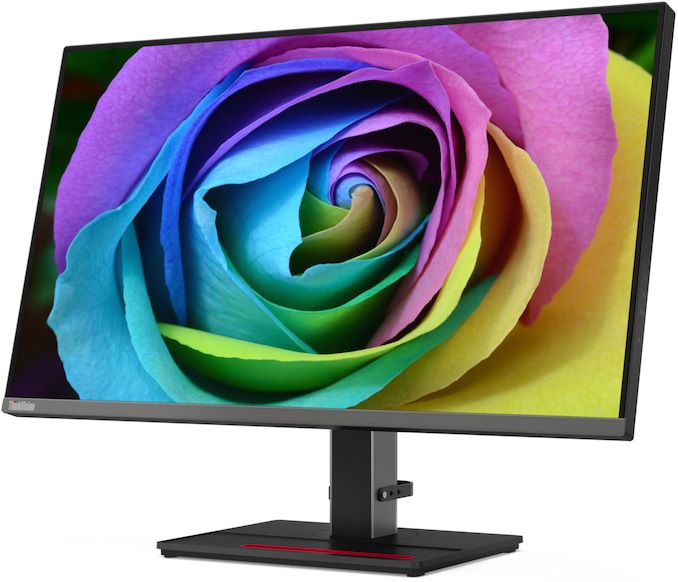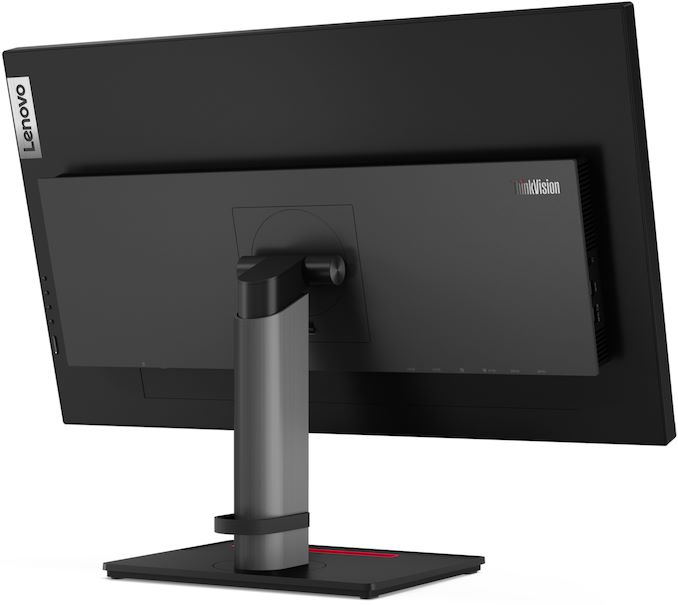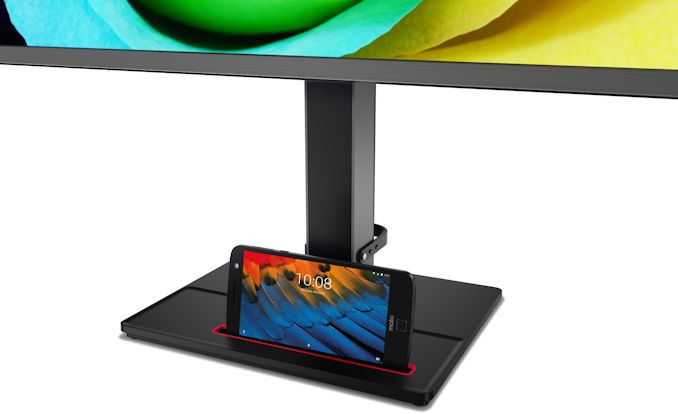Lenovo Unveils ThinkVision Creator Extreme P27: A Professional Monitor with Mini LED FALD
by Anton Shilov on January 3, 2020 2:00 PM EST- Posted in
- Monitors
- Displays
- Lenovo
- IPS
- Trade Shows
- 4K
- ThinkVision
- Mini LED
- CES 2020

Continuing our run of CES 2020 announcements, Lenovo has announced its new ThinkVision Creator Extreme top-of-the-range professional-grade display. The new 27-inch Ultra-HD monitor features a Mini LED-based full-area local dimming (FALD) backlighting that enables a very high brightness in HDR mode along with matching contrast ratios.
As its name suggests, the Lenovo ThinkVision Creator Extreme P27 is designed for various content creators who need a 3840x2160 resolution display with accurate colors (100% of the sRGB and 99% of the DCI-P3 color gamut). The high-end monitor also offers HDR support, with a peak brightness of 1000 nits. The P27 comes factory calibrated and can be used for color-critical workloads by designers or videographers right out of the box.
The key feature of Lenovo’s ThinkVision Creator Extreme P27 is its Mini LED FALD backlighting, which offers 1152 zones (and 10,368 LEDs), three times as many zones as the first generation of FALD PC monitors. This allows the P27 to enable higher contrast ratios, deep blacks (when compared to LCDs with regular WLED backlighting), and the necessary total brightness required for HDR. Lenovo is not disclosing an official contrast ratio specification, though it is safe to say that we are talking about something considerably higher than that of typical IPS displays. The company also does not say which HDR transport formats are supported by the monitor, which is a little bit odd given its positioning.
To meet requirements of users with different computers, Lenovo equipped its ThinkVision Creator Extreme P27 with four display inputs: one DisplayPort 1.4, two HDMI 2.0, and one USB Type-C port with DP 1.4 Alt mode support and 90 W Power Delivery. One interesting feature of the new professional display from Lenovo is a special holder for a smartphone which lets users to follow lock screen announcements and save some space on the desk.
Lenovo’s ThinkVision Creator Extreme P27 will be available this April for $2,499. Considering the fact that to date only Acer and ASUS have introduced Mini LED-enabled professional-grade monitors, the very high price tag of Lenovo’s monitor does not come as a surprise.
| ThinkVision Creator Extreme P27 Specifications | ||
| Panel | 27" IPS | |
| Resolution | 3840 × 2160 | |
| Refresh Rate | 60 Hz | |
| Response Time | 14 ms gray-to-gray | |
| Brightness | Normal: ? cd/m² HDR mode: 1000 cd/m² |
|
| Contrast | ? | |
| Viewing Angles | 178°/178° horizontal/vertical | |
| Color Saturation | 100% sRGB 99% DCI-P3 |
|
| Display Colors | 1.07 billion | |
| 3D-LUT | ? bits | |
| Pixel Pitch | 0.1557 mm² | |
| Pixel Density | 163 PPI | |
| Anti-Glare Coating | ? | |
| Inputs | 1 × DP 1.4 2 × HDMI 2.0b 1 × USB Type-C |
|
| USB Hub | 4-port USB 3.0 hub | |
| Audio | none 3.5-mm mini jack |
|
| Mechanical Design | Chassis Colors: black, metallic. Tilt: yes Height Adjustment: yes Swivel: yes |
|
| Power Consumption | Idle | ? |
| Active | ? | |
| Price | $2,499 | |
Related Reading:
- ASUS ProArt PA32UCG: The Ultimate Mini LED 4K 120 Hz Monitor with HDR 1600
- ASUS Mini LED Professional Monitors Update: Available This Year
- Acer Joins Mini LED Monitor Club with Professional-Focused ConceptD CM7321K
- ASUS at CES 2019: ProArt PA32UCX 4K Monitor with 1000-Zone FALD Unveiled
- AUO’s Mini LED Monitors: 32-Inch 4Kp144, 65-Inch 4Kp144, VR, & Others
- Lenovo Announces ThinkVision P32u LCD: 32-inch, 4K, TB3 with Daisy Chaining
Source: Lenovo













20 Comments
View All Comments
lilkwarrior - Sunday, January 5, 2020 - link
Asus too; the ProArt series surely will have an 8K offering when the I/O makes senselilkwarrior - Sunday, January 5, 2020 - link
Apple would ideally make a 9K-10K monitor.JoeyJoJo123 - Friday, January 3, 2020 - link
>The key feature of Lenovo’s ThinkVision Creator Extreme P27 is its Mini LED FALD backlighting, which offers 1152 zones27" monitor = 2010cm^2 area / 1152 zones = 1.74cm^2 area/zone = about a halo of about 1.32cm x 1.32cm square around your white cursor on a dark background, not to mention the "Response Time 14 ms gray-to-gray", which yeah, shouldn't matter for mastering still imagery, but ghosting is ghosting, and if you're doing video work that ghosting could be a hindrance when trying to edit/master a fast paced action scene or something in the latest snoozefest AAAA hollywood marvel superhero rehash. IMO, LED zones would kind of need to be about .5cm squares before the haloing from LED zones is diminished enough, and even then, it still couldn't compete with OLED in contrast/color/response time/etc.
Any reason why you wouldn't just go OLED if you're already >$2500 for a monitor? https://www.anandtech.com/show/11272/dells-ultrash...
alexdi - Friday, January 3, 2020 - link
This. FALD is fine to consume content, but a non-starter to create it if the zones aren’t small enough to mitigate bloom. I wonder equally how well a dynamic backlight responds to color calibration.s.yu - Friday, January 3, 2020 - link
I was gonna say that this is the minimum for consumption, 10368 zones sound more like it.DanNeely - Sunday, January 5, 2020 - link
Innolux has 32" 4k 120/144hz panels with 10k and 2m dimming zones on the roadmap for mid-year. In addition to the normal HDR certs, they're hoping to get a TrueBlack one nominally intended for OLED displays. Assuming there's minimal blooming effects with one backlight element for every 4 pixels it seems plausible to me. They're hoping to sell the 2M one in both pro and gaming oriented monitors which suggests it shouldn't be too insanely expensive.Hopefully Innolux doesn't run into any major problems with them because rivals AUO and LG are only targeting 1/2k dimming zones in models intended for release this year.
When I bought my 32" 4k60 Gsync Acer Predator a bit over 2 years ago I was expecting it to be my primary display for at least a half dozen years. Assuming the price is manageable though, I might be upgrading to something with the 2M zone Innolux at the end of the year as a self-gift.
https://www.tftcentral.co.uk/blog/innolux-latest-p...
https://www.tftcentral.co.uk/blog/au-optronics-lat...
https://www.tftcentral.co.uk/blog/lg-display-lates...
encryptededdy - Friday, January 3, 2020 - link
Because unfortunately the UP3017Q was only on the market for a few weeks in 2017 and is now impossible to find.lilkwarrior - Sunday, January 5, 2020 - link
Because the bill of material would be too high because there is just too much money to be made making OLED TVs & etc than monitors.Also warranty margins & etc. OLED reference monitors & etc are quite common but consumers have been fickle to do good warranties for.
Alistair - Friday, January 3, 2020 - link
Nope. Give me OLED. I'll take a few of those LG 48" OLED TVs coming out.TristanSDX - Saturday, January 4, 2020 - link
Do professionals really accept such screen for their work ? Halos effect make image disturbed and created images that look correctly on such scrren, when displayed on traditional screen with uniform backlight, will exhibit artifacts. Such devices with FALD / Mini LED may be great for viewing content, but not for creating content.